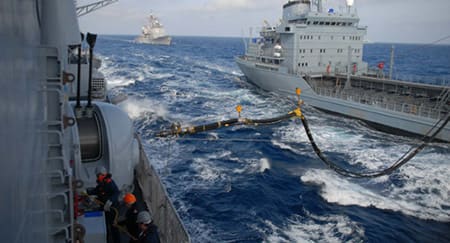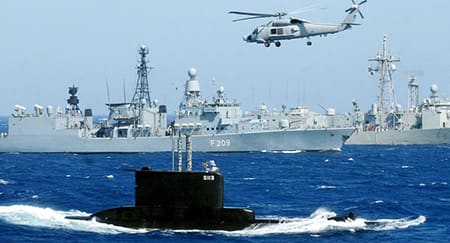Diego A. Ruiz Palmer looks at the growing risks posed at sea, how NATO has reacted and what it needs to do to ensure it keeps pace with a changing maritime risk environment.
At the time of writing, the cost of oil per barrel had reached $100, rekindling concerns over energy supply and transportation.
As more than 90 percent of all trade is sea-bound, maritime security is a key issue –particularly because a significant part of that trade involves large and vulnerable oil and natural gas tankers and the associated off-shore infrastructure.
World-wide ship-borne trade has quadrupled in volume since 1965. In the Mediterranean Sea alone, some 5,000 merchant ships are at sea daily.
Globalization, the easing of movement across borders and the information revolution, means the world’s oceans and seas have become an increasingly accessible environment for criminal activities and potentially hostile endeavours. These range from illegal immigration, human trafficking, weapons smuggling, narcotics trafficking and piracy to terrorism and the proliferation of weapons of mass destruction (WMD) and their means of delivery.
World-wide ship-borne trade has quadrupled in volume since 1965. In the Mediterranean Sea alone, some 5,000 merchant ships are at sea daily
Several international legal instruments and multilateral arrangements to combat illegal seaborne activity are already in place. But only strengthened international cooperation and a multi-tiered response involving intelligence, law enforcement and military capabilities can ensure lasting success.
With this background, it is hardly a surprise that maritime security is steadily moving up on NATO’s agenda.
NATO’s operational record
NATO’s role in maritime security
During the Cold War, regular patrols and periodic live exercises by NATO’s naval forces contributed to the general deterrence of maritime threats inside the NATO area. They also enabled the honing of the Alliance’s distinct skills in the planning and conduct of complex, multinational maritime operations. NATO also developed early patterns of civil-military cooperation for the wartime protection of shipping.
From July 1992 to October 1996, in a departure from the Cold War focus on collective defence, NATO led UN-mandated maritime interdiction operations (MIO) in the Adriatic Sea to enforce economic sanctions against, as well as an embargo on all merchant traffic to and from, the Federal Republic of Yugoslavia.
Starting in June 1993, NATO and the Western European Union (WEU) merged their separate MIOs into a combined operation, Sharp Guard, with a unified command located at the headquarters of NATO’s Allied Naval Forces Southern Europe in Naples, Italy. Between 1992 and 1996, NATO and WEU forces challenged over 74,000 ships, boarded and inspected at sea nearly 6,000 and diverted for inspection in port nearly 1,500.
In the aftermath of the terrorist attacks of 11 September 2001 and the invocation of Article 5 of the North Atlantic Treaty the next day, NATO initiated a maritime counter-terrorism operation – Operation Active Endeavour (OAE) – aimed at deterring terrorist threats in the eastern Mediterranean.
In March 2003, OAE was extended to include escorting merchant shipping in the Strait of Gibraltar and the following month NATO initiated compliant boarding operations undertaken with the consent of the flag state and the ship’s captain. In March 2004, OAE was expanded to the Mediterranean Sea as a whole and later that year OAE transitioned to an intelligence-driven operation focused on tracking and shadowing particular vessels of interest, allowing for a more effective and efficient use of assets. Since its initiation in October 2001, OAE forces have hailed over 88,000 ships, boarded more than 120 suspected ships and escorted nearly 500 ships.
Although a collective defence operation, OAE has been supported by several partner nations, notably the Russian Federation and Ukraine which contributed a warship each in 2006 and again in 2007, as well as Albania, Algeria, Georgia, Israel and Morocco.
In addition to MIOs under NATO command, allied navies also participate in coalition MIOs, such as Operation Enduring Freedom’s Combined Task Force 150. Since 2002, it has brought together maritime forces from 11 NATO and several other nations in an area of operations covering the Gulf of Oman, the Arabian Sea, the Gulf of Aden and the Red Sea.
More recently, following the terrorist attacks on the United States of September 11th, 2001, NATO launched Operation Active Endeavour (OAE) aimed at deterring terrorist threats in the Mediterranean Sea. Since its initiation in October 2001, OAE forces have hailed over 88,000 ships, boarded more than 120 suspected ships and escorted nearly 500 merchant ships across the Strait of Gibraltar.
As an alliance composed of nations with extended coastlines, proud seafaring traditions, large naval capabilities, and extensive trading interests, it is only natural for NATO to have a strong interest in enhancing its contribution to allied and international maritime security.
Two recent maritime interdiction operations (MIOs) highlight how NATO has taken an active role (see box for details). In Operation Sharp Guard conducted in the Adriatic Sea between 1992 and 1996, NATO forces, in cooperation with those of the Western European Union, challenged over 74,000 ships, boarded and inspected at sea nearly 6,000 and diverted for inspection in port nearly 1,500.
As a by-product of their surveillance and interdiction tasks, both Sharp Guard and Active Endeavour have disrupted criminal activities at sea, such as drugs shipments, people trafficking and illegal arms transportation, and their supporting networks.
In both operations, success was dependent to a large extent on good cooperation and information exchange with civilian law enforcement agencies, such as the coast guard, border police and customs, through the experimental NATO Joint Information Analysis Centre (JIAC) located in Naples, Italy, as well as with commercial shipping companies through the NATO Shipping Centre at Northwood, United Kingdom, in consultation with the London-based International Maritime Organization.
Furthermore, in summer 2007, a NATO multinational standing maritime group circumnavigated Africa for the first time, in a demonstration of the Alliance’s concern for securing distant and exposed sea lanes, as well as of its capability to project naval power well beyond NATO’s more traditional European waters.
During this extended two month-long, 12,500 nautical mile deployment, the group patrolled the continent’s coastlines, conducted an exercise with South Africa’s navy and rescued Yemeni military personnel threatened by a sudden volcanic eruption off Yemen’s coastline.
To enhance and expand MIO expertise, in 2004 NATO established a Maritime Interdiction Operational Training Centre in Crete, Greece. This promotes exchange of best practices, development of doctrine, and provision of training in the planning and conduct of MIOs among the Allies and with NATO’s partners. NATO Military Authorities are also developing a concept for maritime security operations that addresses the range of NATO’s potential contributions to maritime security.
[B]A wider perspective on NATO’s roles in maritime security[/B]
The growing need to ensure freedom of navigation and to protect Alliance shipping, territories and populations from a rising tide of mostly non-military seaborne risks would seem to favour NATO assuming a specific and distinct role. This should be complementary to the functions performed by national and international civilian law- enforcement agencies and maritime administrations.
While maritime security operations by nature address all sorts of seaborne risks, NATO should focus particularly on tasks which require timely, high-grade intelligence and permanently-available capabilities – especially where NATO has security interests to safeguard and particular value to add, for example, the protection of energy-related shipping and associated sea-based infrastructure; defence against terrorism; and the prevention of WMD proliferation.
Such a role could revolve around the following core functions:
[UL][LI]the regular patrolling by NATO maritime forces of shipping lanes and choke points, particularly those routinely used by oil and gas tankers, as well as the surveillance of sea-based infrastructure, such as oil rigs and terminals;.[/LI]
[LI]the planning and conduct of maritime security operations either led or supported by NATO, with a focus on complex MIOs requiring skilled and capable forces;[/LI]
[LI]the development of doctrine and civil-military, inter-agency cooperation arrangements, including legal aspects, to facilitate the interaction between naval headquarters and national and international civil agencies;[/LI]
[LI]provision of maritime situational awareness, involving surveillance, intelligence-gathering and information-exchange; in this function, NATO’s maritime headquarters at Naples and Northwood, as well as the NATO Shipping Centre, would play key roles, taking into account the lessons learned from the JIAC experiment, as well as work on achieving a NATO Network-Enabled Capability.[/LI][/UL]
For these purposes, NATO can rely on its four standing maritime groups and five on-call High Readiness Maritime Forces, as well as the expertise resident in its Planning Board for Ocean Shipping, Naval Armaments Group and other bodies.
Cooperation with NATO’s entire range of partners will be paramount, to reflect the ubiquity of maritime risks and to make them stake-holders in their mitigation.
Maritime cooperation can be a particularly effective means to strengthen NATO’s partnerships with Russia and with Ukraine, as well as with the nations of the Mediterranean Dialogue (MD) and the Istanbul Cooperation Initiative (ICI).
Few security issues in the years ahead are likely to attract as much political attention as maritime security, due to its cross-cutting nature, straddling issues of international security
NATO should expand opportunities for these nations’ navies to participate in NATO exercises and attend maritime-oriented courses at NATO’s educational institutions. An increase in NATO port visits to MD and ICI countries and in local “passage exercises” (PASSEX) with their navies should also be considered.
Bucharest and beyond
At NATO’s Riga Summit in November 2006, NATO Heads of State and Government already tasked assessments on energy security, reflecting a growing concern over risks to energy supply, infrastructure and shipping. Few security issues in the years ahead are likely to attract as much political attention as maritime security, due to its cross-cutting nature, straddling issues of international security, sovereignty, energy assurance, economic prosperity, law enforcement and defence.
The forthcoming NATO Bucharest Summit will take stock of progress in developing an Alliance maritime situational awareness capability. This is a necessary step in establishing a baseline for a better structured NATO role in enhancing maritime security -- including maritime aspects of energy security – which draws on the Alliance’s well-established operational record and capabilities. Other steps beyond Bucharest should follow, reflecting a growing consensus that maritime security is one of the defining security challenges of this century.



